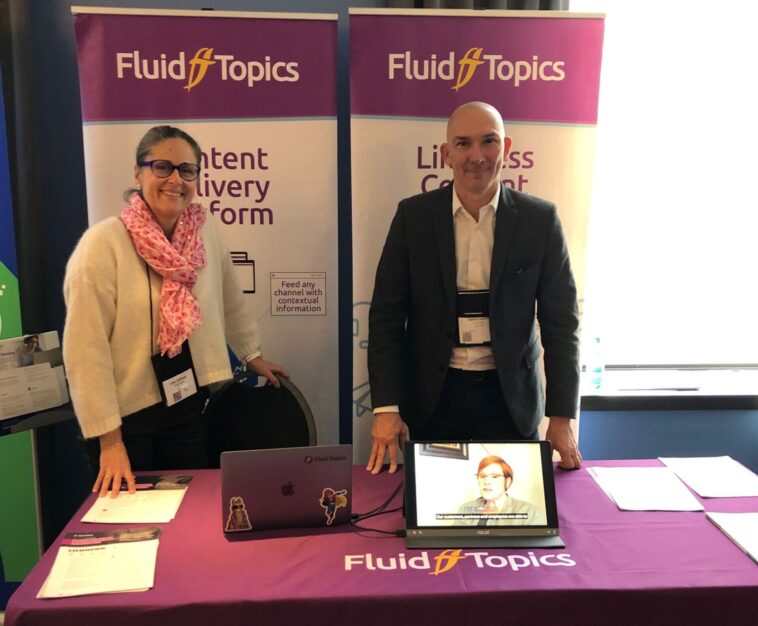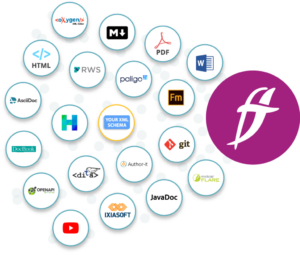And that’s a wrap! Thank you to CIDM for having us at this year’s ConVEx Minneapolis, an immersive experience for Content Professionals. Fluid Topics’ CEO, Fabrice Lacroix, and Senior Account Manager, Lola Caillaud, had a great time exploring the latest innovations and attending insightful conferences. Among the many riveting presentations, Fabrice was pleased to host two of his own sessions: “GenAI: Promises vs Tech Doc Realities” and “GenAI at Work with Fluid Topics”. There he highlighted concrete ways to integrate Generative AI (GenAI) into content strategies and the practical challenges faced when implementing it.

While the team was in the land of 10,000 lakes, they took note of the latest trends in information development. It was quickly evident that discussions revolved around the implications of GenAI on content. Attendees also shared best practices for using this increasingly popular technology to highlight the value of the content businesses produce.
First things first — at the heart of these trends is understanding how valuable content is to GenAI. And since GenAI algorithms can only create results as good as the content that feeds them, it’s extremely important. Read on to be the first to discover the latest insights from ConVEx outlined below so you can upgrade your content strategy.
Insight 1: Gather all Content to Maximize Value
With the need for quality content forever increasing, C-levels are discovering just how much documentation their companies have. While knowledge assets are often scattered across silos, organizations need to gather content from all sources — CCMS, LMS, Github, Sharepoint, helpdesk tools, Wikis.
Each new piece of content helps the algorithm better understand the nuances of a company or a product, enabling GenAI to provide accurate, contextualized answers. Otherwise, these tools rely on LLMs that excel at understanding and generating natural language but can’t provide specific product answers. This is why there is a need to create a single, vetted source of truth in a centralized location. One easy way to create this content hub is by using a Content Delivery Platform (CDP), as Fabrice Lacroix explained in his presentation “GenAI: Promises vs Tech Doc Realities”. A CDP does the work of collecting a company’s product knowledge from any source and in any format. It harmonizes this content into a unified content repository and makes the content available across endpoints via APIs.

Insight 2: Select Solutions that Ensure Content Security
While selecting up-and-coming GenAI tools, companies need to ensure that this technology has airtight security. Most companies adopting GenAI have concerns, with 92% of executives saying it introduces moderate to high risks for their businesses.
There’s one big risk in particular for companies using retrieval augmented generation (RAG) with their GenAI tools. Organizations need to compute embeddings based on content data to optimize RAG for responses that accurately reference their knowledge base. Then, the model can retrieve information from internal knowledge sources, combining this with responses in natural language.
Businesses need to ensure that their internal, confidential content is not leaked. This can happen while the algorithm retrieves data from their product knowledge base to enhance the LLM’s outputs. To complete the retrieval, an external source may need to process the content and compute the embeddings needed to identify the relevant knowledge. Therefore, companies should ensure their solution providers have clear precautions and protocols in place. Ensuring company data protection and content governance is of the utmost importance.
But don’t worry! While this concern is valid, secure solutions do exist. For example, at Fluid Topics, we’ve solved this issue by integrating the embeddings and vector database management into our content delivery platform. Therefore, our customers’ content is processed internally during this retrieval step. As a result, the platform’s security is more robust and ensures the protection of classified and internal information. Companies need this level of security to ensure their AI projects guarantee the integrity and confidentiality of knowledge assets.
Insight 3: Transition Content from Cost Center to Revenue Generator
Additionally, the relationship between content and GenAI is not one sided. While content feeds GenAI, this technology is also transforming the role of content. Thus, companies implementing GenAI tools are now upgrading their content hubs from cost centers to savings enablers and even revenue generators.
Cases show that accurate, up-to-date, and easily found technical documentation improves case deflection via customer self-service. As Scott Abel discussed in his presentation “Exploring the Future of Customers”, self-service avoids churn as customers find their answers and leave satisfied. Moreover, reducing churn is an efficient way to enable savings in today’s competitive market where loyalty is easily swayed. With GenAI tools, self-service becomes even easier, allowing users to access accurate product answers in natural language for any question.
In addition to the funds saved, GenAI also expands the upsell potential for content, opening doors to new revenue streams through original features and functionalities:
- Premium SLAs: McKinsey found that found that AI technologies automate employees’ tasks that take between 60% to 70% of their time, allowing them to complete missions faster. By taking advantage of this, companies can offer premium SLAs thanks to GenAI features that enhance operational efficiency. One such use is Fluid Topics’ tools and parts extraction which details the required materials for field services thereby increasing uptime with faster and more efficient service calls.
- In-product assistance: Consumers want to easily access support without breaking their workflow by going to a help center. Adobe’s Acrobat AI assistant upgrades static in-product assistance to help premium users understand the contents of digital documents.
- Next-gen chatbots: Companies are harnessing LLMs to upgrade their chatbots to provide a human-like support experience. For example, AI chatbot subscription services like You.Com provide users with personalized information whenever they need it. Content Delivery Platforms combine LLMs with RAG to take this chatbot experience to the next level, helping users find contextual product information for a given company.

Insight 4: Get C-Level Buy-In via Tech Writers
To complement this insight, using content to generate revenue is a great way for tech doc teams to get a seat at the table and take on a leadership role within companies. Pressure is growing for leadership to prove to the board that their organization is a forward-thinking company. Hence, one of the most promising ways for them to do this is to invest in the latest technologies, including GenAI, to stay ahead of the competition.
Technical documentation teams can help company leadership achieve this easily with a content delivery platform. It’s simple: GenAI needs content. The content already exists, technical writing teams own it, and a CDP allows companies to centralize and secure it. Plus CDPs equipped for GenAI function as LLM gateways. A gateway creates a technical layer between app interfaces (chatbots, virtual assistants, in-app troubleshooting, support platforms) and the language models used by GenAI. With this, the latest CDPs provide out-of-the-box services for powering Retrieval Augmented Generation (RAG) scenarios, managing prompts, and enriching applications with GenAI capabilities.
Presentation All-Stars
Furthermore, some of the other note-worthy presentations our teams were thrilled to attend include:
- “Unlock Your Content’s Potential: A Transformative Information Management Case Study” featuring Johnathan Chandler from Intralox and Mike Rice from Content Rules.
- “Leveraging Generative AI for Improving User Enablement” by Meenakshi Dwivedi from SAP.
- “Meet your New Audience: Artificial Intelligence” with Dawn Stevens and Dana Aubin from Comtech Services.
Final Thoughts
Overall, ConVEx 2024 was a great success as the many interesting discussions and presentations clearly illuminated the path to optimizing use of GenAI tools while highlighting both the risks and benefits.
If you have questions about any of these trends, want more information about Fabrice’s conferences, or want to learn more about how we ensure a comprehensive content strategy at Fluid Topics, reach out to our team! We’re happy to talk and will get back to you quickly.
Latest post





